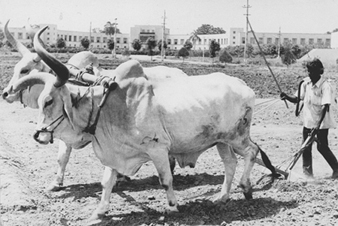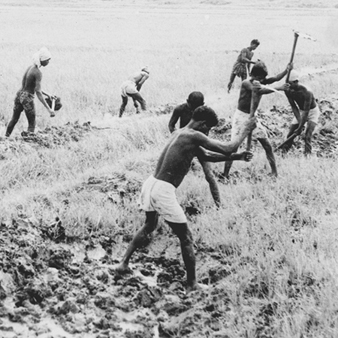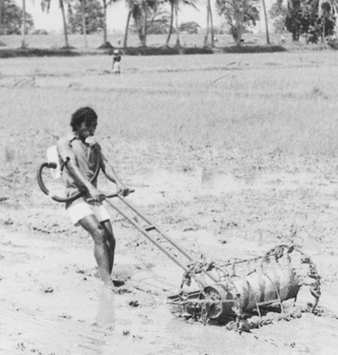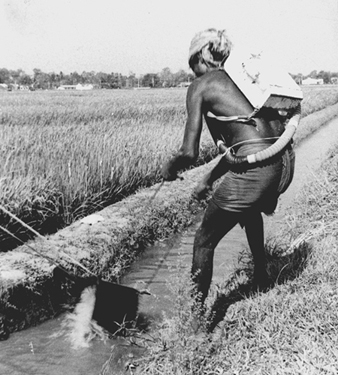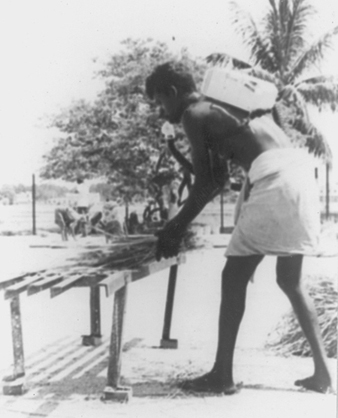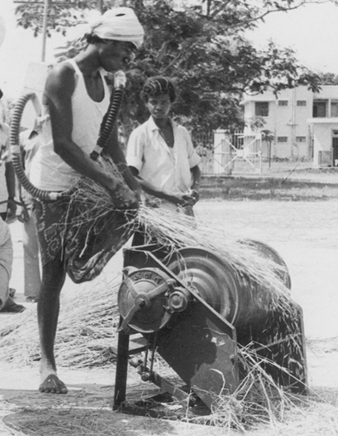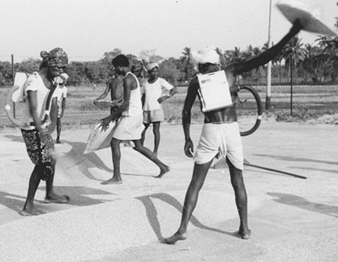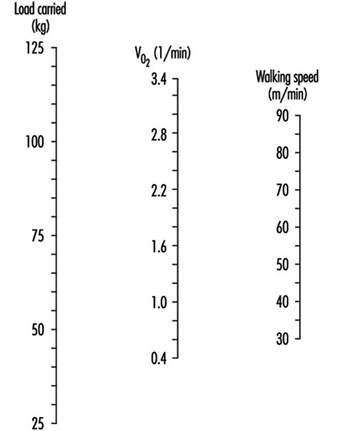
Nag, Pranab Kumar
Address: National Institute of Occupational Health, Meghani Nagar, Ahmedabad 380-016
Country: India
Phone: 91 79 786 7351
Fax: 91 79 786 6630
Past position(s): Senior Research Officer, Department of Ergonomics and Environmental Physiology
Education: BSc, 1970, University of Calcutta, India; MSc, 1972, University of Calcutta, India; PhD, 1977, University of Calcutta, India; DSc, 1991, University of Calcutta, India
Areas of interest: Macro ergonomics and organizational design; anthropometry; biomechanics and environmental physiology
Manual Operations in Farming
Agricultural methods and practices vary across national boundaries:
- industrial agriculture—industrialized countries of the West (temperate climate) and specialized sectors of the tropical countries
- green revolution agriculture—well endowed areas in the tropics, primarily irrigated plains and deltas of Asia, Latin America and North Africa
- resource-poor agriculture—hinterlands, dry lands, forests, mountains and hills, near deserts and swamps. About 1 billion people in Asia, 300 million in sub-Saharan Africa and 100 million in Latin America are dependent on this form of agriculture. Women comprise a large proportion of subsistence farmers—nearly 80% of the food for sub-Saharan Africa, 50 to 60% of Asia’s food, 46% of the Caribbean’s food, 31% of North Africa and the Middle East’s food and 30% of Latin America’s food is produced by women (Dankelman and Davidson 1988).
With distinct agro-climatic features, the farm crops are grouped as follows:
- Field crops (cereals, oilseeds, fibre, sugar and fodder crops) are rain-fed or cultivated through controlled irrigation.
- Upland and semi-upland cultivation (wheat, groundnuts, cotton and so on) are practised where irrigation or rain water is not abundantly available.
- Wetland cultivation (rice crops) is practised where the land is ploughed and puddled with 5 to 6 cm of standing water and seedlings are transplanted.
- Horticulture crops are fruit, vegetable and flower crops.
- Plantation or perennial crops include coconut, rubber, coffee, tea and so on.
- Pastures are anything nature grows without human intervention.
Farming Operations, Hand Tools and Machinery
Farming in the tropical countries is labour intensive. The ratio of rural population to arable land in Asia is twice as great as in Africa and three times that of Latin America. It is estimated that human effort provides more than 70% of the energy required for crop production tasks (FAO 1987). Improvement in the existing tools, equipment and methods of work has significant effects in minimizing human strain and fatigue and increasing farm productivity. For field crops, farm activities may be categorized based on the physiological demand of work with reference to an individual’s maximal working capacity (see table 1).
Table 1. Categorization of farm activities
|
Work severity |
Farm operations |
|||
|
Seed bed preparation |
Sowing |
Weeding and intercultivation |
Harvesting |
|
|
Light work |
Laddering (two workers) |
Broadcasting seeds/fertilizer, scaring birds, ridging |
Fertilizer broadcasting |
Grain cleaning, grading, spreading vegetables (squatting), pounding grain (helper), winnowing (sitting) |
|
Moderately heavy work |
Walking behind animal-drawn implement, levelling soil surface with wooden rake, laddering (one worker), digging soil with spade, bush cutting |
Manual uprooting of seedlings (squatting and bent posture), transplanting seedlings (bent posture), walking on a puddled field |
Manual weeding with sickle and hand hoe (squatting and bent posture), channel irrigation, knapsack spraying of pesticides, weeder operation in wet and dry soil |
Cutting crops, harvesting paddy, wheat (squatting and bent posture), plucking vegetables, manual winnowing (sitting and standing), cutting sugarcane, pedal-thresher helper, carrying load (20-35 kg) |
|
Heavy work |
Ploughing, water lifting (swing busket), hoeing dry soil, bund trimming wet soil, spade work, disc harrowing |
Weeder operation in dry soil |
Grain threshing by beating, pounding grain |
|
|
Extremely heavy work |
Bund trimming dry soil |
Germinating seeder operation in puddled field |
Pedal threshing, carrying load on head or yoke (60-80 kg) |
|
Source: Based on data from Nag, Sebastian and Marlankar 1980; Nag and Chatterjee 1981.
Seed-bed preparation
A suitable seed-bed is one that is mellow yet compact and free from vegetation that would interfere with seeding. Seed-bed preparation involves use of different types of hand tools, shallow chisel desi or a mould board plough pulled by draft animals (figure 1) or tractor implements for ploughing, harrowing and so on. About 0.4 hectare (ha) of land can be tilled by a bullock-drawn plough in a day, and a pair of bullocks can provide power to the extent of 1 horsepower (hp).
Figure 1. Bullock-drawn shallow chisel desi plough
In using animal-drawn equipment, the worker acts as a controller of animals and guides the implement with a handle. In most cases, the operator walks behind the implement or sits on the equipment (e.g., disc harrows and puddlers). The operation of animal-drawn implements involves considerable human energy expenditure. For a 15 cm plough, a person may walk about 67 km to cover a 1-hectare area. At a walking speed of 1.5 km/h, the human energy expenditure amounts to 21 kJ/min (about 5.6 × 104 kJ per ha). A handle on implements that is too long or too short results in physical discomfort. Gite (1991) and Gite and Yadav (1990) suggested that the optimum handle height of an implement may be adjusted between 64 and 84 cm (1.0 to 1.2 times the metacarpal III height of the operator).
Hand tools (spade, shovel, hoe and so on) are used for digging and loosening the soil. To minimize drudgery in shovelling work, Freivalds (1984) deduced the optimum rate of work (i.e., shovelling rate) (18 to 21 scoops/minute), shovel load (5 to 7 kg for 15 to 20 scoops/minute, and 8 kg for 6 to 8 scoops/minute), throw distance (1.2 m) and throw height (1 to 1.3 m). Recommendations also include a shovel lift angle of about 32°, a long tool handle, a large, square-pointed blade for shovelling, a round-pointed blade for digging and hollow back construction to reduce shovel weight.
Nag and Pradhan (1992) suggested low-lift and high-lift hoeing tasks (see figure 2), based on physiological and biomechanical studies. As a general guide, the method of work and the hoe design are the deciding factors in performance efficiency of hoeing tasks (Pradhan et al. 1986). The mode of striking the blade to the ground determines the angle at which it penetrates the soil. For low-lift work, the work output was optimized at 53 strokes/ minute, with a land area dug of 1.34 m2/minute, and a work-rest ratio of 10:7. For high-lift work, the optimal conditions were 21 strokes per minute and 0.33 m2/minute of land dug. The shape of the blade—rectangular, trapezoidal, triangular or circular—depends upon the purpose and preference of the local users. For different modes of hoeing, the recommended design dimensions are: weight 2 kg, angle between blade and handle 65 to 70° , handle length 70 to 75 cm, blade length 25 to 30 cm, blade width 22 to 24 cm and handle diameter 3 to 4 cm.
Figure 2. Hoeing tasks in bund trimming in paddy field
Pranab Kumar Nag
Sowing/planting and fertilizer application
The sowing of seeds and planting of seedlings involve the use of planters, seeders, drills and the manual broadcasting of seeds. About 8% of total person-hours are required for broadcasting of seeds and uprooting and transplanting of seedlings.
- In the broadcasting of seeds/fertilizer by hand, manually operated broadcasters allow uniform distribution with minimum drudgery.
- Seeding behind a plough consists of sowing of seeds in a furrow opened by a wooden plough.
- In drilling, seeds are placed in the soil by a seed drill or seed-cum-fertilizer drill. The push/pull force required for a worker to operate the drill (manual or animal-drawn units mounted on wheels) is an important design consideration.
- Dibbling is the placing of seeds by hand or with a small implement (a dibbler), at an average spacing of 15 x 15 cm or 25 x 25 cm. Abrasion of fingers and bodily discomfort due to bent and squat postures are common complaints.
- In planting, sugar cane sets are planted at 30 cm length in a furrow; potato seed tubers are planted flat and ridges are made.
- About 1/3 of the world’s rice is grown by the transplanting system. This is also done for tobacco and some vegetable crops. Usually, germinating seeds are broadcasted densely on a puddled field. The seedlings are uprooted and transplanted to a puddled field by hand or with manual or power-operated transplanters. The operator of a manually operated transplanter walks behind the unit to operate the handle mechanism to pick and transplant the seedlings.
For manual transplanting, the workers are required to be immersed knee deep in mud. The squatting posture used for planting on dry land, with one or two legs flexed at the knee, cannot be adopted in a watered field. About 85 person-hours are required to transplant seedlings for each hectare of land. The awkward posture and static load exert strain on the cardiovascular system and cause low-back pain (Nag and Dutt 1980). Manually operated seeders produce higher work output (i.e., a seeder is about eight times more efficient than transplanting by hand). However, maintaining the balance of the machine (see figure 3) in a puddled field requires about 2.5 times more energy than manual transplanting.
Figure 3. Operating an improved germinated seeder
Paranab Kumar Nag
Plant protection
Fertilizer, pesticide, herbicide and other chemical applicators are operated by pressure through nozzles or by centrifugal force. Large-scale spraying is based on the hydraulic nozzle spray atomizer, either manually operated or using tractor-mounted equipment. Knapsack sprayers are scaled-down models of vehicle-mounted sprayers (Bull 1982).
- A compression knapsack sprayer consists of a tank, a pump and a rod with nozzle and hose.
- A lever-operated knapsack sprayer (10 to 20 l) has an operating lever.
- A power knapsack sprayer consists of a chemical tank of about 10-litre capacity and an air-cooled engine of 1 to 3 hp. The sprayer and engine unit is mounted on a frame and carried on the operator’s back.
- A hand-operated bucket sprayer and foot-operated sprayer require two persons for operating the pump and spraying. A rocking sprayer is operated by the rocking (forward and backward) movement of the handle lever.
When carried on the shoulder for prolonged periods, the vibrations of knapsack sprayers/chemical applicators have detrimental effects on the human body. Spraying using a knapsack sprayer results in potential skin exposure (the legs experience 61% of the total contamination, the hands 33%, the torso 3%, the head 2%, and the arms 1%) (Bonsall 1985). Personal protective clothing (including gloves and boots) can reduce the dermal contamination of pesticides (Forget 1991, 1992). The work is quite strenuous, due to carrying of the load on the back as well as continuous operation of the sprayer handle (20 to 30 strokes/minute); in addition, there is the thermoregulatory load due to protective garments. The weight and height of the sprayer, shape of sprayer tank, mounting system and force required to operate the pump are important ergonomic aspects.
Irrigation
Irrigation is a prerequisite for intensive cropping in arid and semi-arid regions. Since time immemorial, various indigenous devices have been used for lifting water. Lifting water by different manual methods is physically strenuous. In spite of the availability of water pump sets (electrical or engine powered), manually operated devices are widely used (e.g., swing baskets, counterpoise water lifts, water wheels, chain and washer pumps, reciprocating pumps).
- A swing basket is used for lifting water from an irrigation channel (see figure 4). The capacity of the basket is about 4 to 6 l and the frequency of operation is about 15 to 20 swings/minute. Two operators work at right angles to the direction of basket motion. The work demands heavy physical activity, with adoption of awkward body movements and posture.
- A counterpoise water lift consists of a container attached to the end of a horizontal lever which is supported on a vertical pole. The worker exerts force on the counterweight to operate the device.
- Reciprocating pumps (piston-cylinder type hand pumps) are operated either by hand in reciprocating mode or by pedalling in rotary mode.
Figure 4. Lifting water from irrigation channel using a swing basket
Pranab Kumar Nag
Weeding and intercultivation
Undesirable plants and weeds cause losses by impairing crop yields and quality, harbouring plant pests and increasing irrigation cost. Reduction in yield varies from 10 to 60% depending upon the thickness of growth and the kind of weeds. About 15% of human labour is spent in removing weeds during the cultivating season. Women typically comprise a large portion of the workforce engaged in weeding. In a typical situation, a worker spends about 190 to 220 hours weeding one hectare of land by hand or hand hoe. Spades are also used for weeding and intercultivation.
Of several methods (e.g., mechanical, chemical, biological, cultural), mechanical weeding, either by pulling out the weeds by hand or with hand tools like the hand hoe and simple weeders, is useful in both dry and wet land (Nag and Dutt 1979; Gite and Yadav 1990). In dry land, the workers squat on the ground with one or two legs flexed at the knee and remove weeds using a sickle or hand hoe. In watered land, the workers adopt a bent forward stooping posture to remove weeds manually or with the help of weeders.
The physiological demand in using weeders (e.g., blade and rake, projection finger, double sweep type weeders) is relatively higher than in manual weeding. However, the efficiency of work in terms of area covered is significantly better with the weeders than with manual weeding. The energy demand in manual weeding jobs is only about 27% of one’s working capacity, whereas for different weeders, the energy demand goes up to 56%. However, the strain is relatively less in the case of wheel hoe-type weeders, with which it takes about 110 to 140 person-hours to cover one hectare. A wheel hoe-type weeder (push/pull) consists of one or two wheels, a blade, a frame and a handle. A force (push or pull) of about 5 to 20 kilograms of force (1 kgf = 9.81 Newtons) is required, with a frequency of about 20 to 40 strokes per minute. The technical specifications of the wheel hoe-type weeders, however, need to be standardized for better operation.
Harvesting
In rice and wheat crops, harvesting requires 8 to 10% of the total person-hours used in crop production. Despite rapid mechanization in harvesting, large-scale dependence on manual methods (see figure 5) will continue for years to come. Hand tools (sickle, scythe and so on) are used in manual harvesting. The scythe is commonly used in some parts of the world, because of its large area of coverage. However, it requires more energy than harvesting with a sickle.
Figure 5. Harvesting wheat crop using a sickle
Pranab Kumar Nag
The popularity of the sickle is due to its simplicity in construction and operation. A sickle is a curved blade, with a smooth or serrated edge, attached to a wooden handle. Sickle design varies from region to region, and there is a difference in cardiorespiratory load with different types of sickles. The output varies from 110 to 165 m2/hour, values corresponding to 90 and 60 person-hours per hectare of land. Awkward work postures may lead to long-term clinical complications relating to the back and to the joints of the limbs. Harvesting in a bent posture has the advantage of mobility on both dry and wet land, and it is about 16% faster than squatting; however, a bent posture is 18% more energy demanding than squatting (Nag et al. 1988).
Harvesting accidents, lacerations and incised wounds are common in paddy, wheat and cane sugar fields. The hand tools are primarily designed for right-handed persons, but are often used by left-handed users, who are unaware of the possible safety implications. The important factors in a sickle design are the blade geometry, blade serration, handle shape and size. Based on an ergonomics study, suggested design dimensions of a sickle are: weight, 200 g; total length, 33 cm; handle length, 11 cm; handle diameter, 3 cm; radius of blade curvature, 15 cm; blade concavity, 5 cm. For a serrated sickle: tooth pitch, 0.2 cm; tooth angle, 60°; and ratio of the length of cutting surface to chord length, 1.2. Since the workers perform activities under extreme climatic conditions, health and safety issues are critically important in tropical farming. The cardiorespiratory strain accumulates over long hours of work. Extreme climatic conditions and heat disorders place added stress on the worker and diminish working capacity.
Harvesting machines include mowers, choppers, balers and so on. Power-operated or animal-drawn reapers are also used for harvesting field crops. Combine harvesters (self-propelled or tractor operated) are useful where intensive cultivation is practised and the labour shortage is acute.
Harvesting of sorghum is done by cutting the ear-head and then cutting the plant, or vice versa. The cotton crop is collected in 3 to 5 pickings by hand as the ball matures. Harvesting of potatoes and sugar beets is done manually (see figure 6) or by using a blade harrow or digger, which may be animal or tractor powered. In the case of groundnuts, the vines are either pulled manually or removed using diggers, and the pods separated.
Figure 6. Manual harvesting of potatoes with a hand hoe
Threshing
Threshing includes separation of grains from the earheads. Age-old manual methods of threshing of grain from the paddy pinnacle are: rubbing the earheads with one’s feet, beating of the harvested crop on a plank, animal treading and so on. Threshing is classified as a moderately heavy task (Nag and Dutt 1980). In manual threshing by beating, (see figure 7) one separates about 1.6 to 1.8 kg of grain and 1.8 to 2.1 kg of straw per minute from medium sized paddy/wheat plants.
Figure 7. Threshing paddy pinnacle by beating
Pranab Kumar Nag
Mechanical threshers carry out threshing and winnowing operations simultaneously. The pedal thresher (oscillating or rotary mode) increases the output to 2.3 to 2.6 kg of grain (paddy/wheat) and 3.1 to 3.6 kg of straw per min. Pedal threshing (see figure 8) is a more strenuous activity than manual threshing by beating. The pedalling and holding of paddy plants on the rolling drum result in high muscular strains. Ergonomic improvements in the pedal thresher may allow a rhythmic pattern of leg work in alternate sitting and standing postures and minimize postural strains. The optimal momentum of the thresher may be reached at about 8 kg weight of the rolling drum.
Figure 8. A pedal thresher in operation
Pranab Krumar Nag
Power threshers are gradually being introduced in green revolution areas. Essentially they consist of a prime mover, a threshing unit, a winnowing unit, a feeding unit and a outlet for clean grain. Self-propelled combines are a combination of a harvester and a thresher unit for grain crops.
Fatal accidents have been reported in grain threshing using power threshers and fodder cutters. The incidence of moderate to severe thresher injuries was 13.1 per thousand threshers (Mohan and Patel 1992). Hands and feet can be injured by the rotor. The position of the feeding chute can result in awkward postures when feeding the crop into the thresher. The belt powering the thresher is also a common cause of injuries. With fodder cutters, the operators can sustain injury while feeding the fodder into the moving blades. Children sustain injury when playing with the machines.
The workers often stand on unstable platforms. In the event of a jerk or loss of balance, the torso weight pushes the hands into the threshing drum/fodder cutter. The thresher must be designed so that the feeding chute is at elbow level and the operators stand on a stable platform. The design of the fodder cutter may be improved for safety as follows (Mohan and Patel 1992):
- a warning roller placed on the chute before the feed rollers
- a locking pin to fix the flywheel when the cutter is not in use
- gear cover and blade guards to push limbs away and prevent clothes from getting entangled.
For threshing groundnuts, the traditional practice is to hold the plants by one hand and strike them against a rod or grill. For threshing maize, tubular maize shellers are used. The worker holds the equipment in his or her palm and inserts and rotates cobs through the equipment to separate the maize grains from the cobs. Output with this equipment is about 25 kg/hour. Hand-operated rotary type maize shellers have higher work output, about 50 to 120 kg/hour. The length of the handle, the force required to operate it and the speed of operation are the important considerations in hand-operated rotary maize shellers.
Winnowing
Winnowing is a process to separate grains from chaff by blowing air, using a hand fan or a pedal- or motor-driven fan. In manual methods (see figure 9), the whole content is thrown up in the air, and the grain and chaff get separated out by differential momentum. A mechanical winnower may, with considerable human exertion, be hand or pedal operated.
Figure 9. Manual winnowing
Pranab Kumar Nag
Other post-harvest operations include cleaning and grading of grains, shelling, decortication, hulling, peeling, slicing, fibre extraction and so on. Different types of manually operated equipment are used in post-harvest operations (e.g., potato peelers and slicers, coconut dehuskers). Decortication involves breaking of shells and removal of seeds (e.g., groundnuts, castor beans). A groundnut decorticator separates kernels from pods. Manual decortication has a very low output (about 2 kg of pod shelling per person-hour). Workers complain of bodily discomfort due to the continuous sitting or squatting posture. Oscillating or rotary-mode decorticators have an output of about 40 to 60 kg of pods per hour. Shelling and hulling refer to separation of seed coat or husk from the inner portion of the grain (e.g., paddy, soybean). Traditional rice hullers are manually (hand or foot) operated and are widely used in rural Asia. The maximum force which can be exerted by hand or foot determines the size and other characteristics of the device. Nowadays, motorized rice mills are used for hulling. In some grains, such as pigeonpea, the seed coat or husk is tightly attached. Removal of the husk in such cases is called dehusking.
For different hand tools and manually operated implements, the grip size and the force exerted on the handles are important considerations. In the case of shears, the force which can be applied by two hands is important. Although most injuries related to hand tools are classified as minor, their consequences are often painful and disabling because of delayed treatment. Design changes in hand tools should be limited to those that can be easily fabricated by village artisans. Safety aspects need to be given due consideration in powered equipment. Safety shoes and gloves available at present are far too expensive and are not suitable for farmers in the tropics.
Manual material-handling tasks
Most agricultural activities involve manual material-handling tasks (e.g., lifting, lowering, pulling, pushing and carrying of heavy loads), resulting in musculoskeletal strains, falls, spinal injuries and so on. The fall injury rate increases dramatically when the fall height is more than 2 m; impact forces are reduced manyfold if the victim falls on soft earth, hay or sand.
In rural areas, loads weighing 50 to 100 kg might be carried several miles on a daily basis (Sen and Nag 1975). In some countries, women and children have to fetch water in large quantities from a distance. These arduous tasks need to be minimized to the extent possible. Different methods of water carriage involve carrying on the head, on the hip, on the back and on the shoulder. These have been associated with a variety of biomechanical effects and spinal disorders (Dufaut 1988). Attempts have been made to improve shoulder load-carrying techniques, designs of wheelbarrows and so on. Load transportation using transverse yoke and head load are more efficient than the frontal yoke. The load optimization that can be carried by men may be obtained from the nomogram shown (figure 10). The nomogram is based on a multiple regression drawn between oxygen demand (the independent variable) and load carried and walking speed (the dependent variables). One may put a scale on the graph across the variables to identify the result. Two variables must be known to find the third. For example, with an oxygen demand of 1.4 l/min (approximate equivalent of 50% of one’s maximum working capacity) and walking speed of 30 m/min, the optimum load would be about 65 kg.
Figure 10. A nomogram to optimize load to be carried on head/yoke, with reference to walking speed and oxygen demand of work.
In view of the diversity of farm activities, certain organizational measures towards redesigning of tools and machinery, methods of work, installation of safety guards on machinery, optimization of human exposure to adverse work environment and so on may significantly improve conditions of work for farming populations (Christiani 1990). Extensive ergonomic research on farm methods and practices, tools and equipment may generate a great deal of knowledge for the betterment of health, safety and productivity of billions of agricultural workers. This being the world’s largest industry, the primitive image of the sector, particularly the resource-poor tropical agriculture, could be transformed as task-oriented. Thus rural workers can undergo systematic training on the hazards of jobs, and safe operational procedures can be developed.
Checklists
Work systems encompass such macro level organizational variables as the personnel subsystem, the technological subsystem and the external environment. The analysis of work systems is, therefore, essentially an effort to understand the allocation of functions between the worker and the technical outfit and the division of labour between people in a sociotechnical environment. Such an analysis can assist in making informed decisions to enhance systems safety, efficiency in work, technological development and the mental and physical well-being of workers.
Researchers examine work systems according to divergent approaches (mechanistic, biological, perceptual/motor, motivational) with corresponding individual and organizational outcomes (Campion and Thayer 1985). The selection of methods in work systems analysis is dictated by the specific approaches taken and the particular objective in view, the organizational context, the job and human characteristics, and the technological complexity of the system under study (Drury 1987). Checklists and questionnaires are the common means of assembling databases for organizational planners in prioritizing action plans in areas of personnel selection and placement, performance appraisal, safety and health management, worker-machine design and work design or redesign. Inventory methods of checklists, for example the Position Analysis Questionnaire, or PAQ (McCormick 1979), the Job Components Inventory (Banks and Miller 1984), the Job Diagnostic Survey (Hackman and Oldham 1975), and the Multi-method Job Design Questionnaire (Campion 1988) are the more popular instruments, and are directed to a variety of objectives.
The PAQ has six major divisions, comprising 189 behavioural items required for the assessment of job performance and seven supplementary items related to monetary compensation:
- information input (where and how does one get information on the jobs to perform) (35 items)
- mental process (information processing and decision-making in performing the job) (14 items)
- work output (physical work done, tools and devices used) (50 items)
- interpersonal relationships (36 items)
- work situation and job context (physical/social contexts) (18 items)
- other job characteristics (work schedules, job demands) (36 items).
The Job Components Inventory Mark II contains seven sections. The introductory section deals with the details of the organization, job descriptions and biographical details of the job holder. Other sections are as follows:
- tools and equipment—uses of over 200 tools and equipment (26 items)
- physical and perceptual requirements—strength, coordination, selective attention (23 items)
- mathematical requirements—uses of numbers, trigonometry, practical applications, e.g., work with plans and drawings (127 items)
- communication requirements—the preparation of letters, use of coding systems, interviewing people (19 items)
- decision-making and responsibility—decisions about methods, order of work, standards and related issues (10 items)
- job conditions and perceived job characteristics.
The profile methods have common elements, that is, (1) a comprehensive set of job factors used to select the range of work, (2) a rating scale that permits the evaluation of job demands, and (3) the weighing of job characteristics based on organizational structure and sociotechnical requirements. Les profils des postes, another task profile instrument, developed in the Renault Organization (RNUR 1976), contains a table of entries of variables representing working conditions, and provides respondents with a five-point scale on which they can select the value of a variable that ranges from very satisfactory to very poor by way of registering standardized responses. The variables cover (1) the design of the workstation, (2) the physical environment, (3) the physical load factors, (4) nervous tension, (5) job autonomy, (6) relations, (7) repetitiveness and (8) contents of work.
The AET (Ergonomic Job Analysis) (Rohmert and Landau 1985), was developed based on the stress-strain concept. Each of the 216 items of the AET are coded: one code defines the stressors, indicating whether a work element does or does not qualify as a stressor; other codes define the degree of stress associated with a job; and yet others describe the duration and frequency of stress during the work shift.
The AET consists of three parts:
- Part A. The Man-at-Work system (143 items) includes the work objects, tools and equipment, and work environment constituting the physical, organizational, social and economic conditions of work.
- Part B. The Task analysis (31 items) classified according to both the different kinds of work object, such as material and abstract objects, and worker-related tasks.
- Part C. The Work Demand analysis (42 items) comprises the elements of perception, decision and response/activity. (The AET supplement, H-AET, covers body postures and movements in industrial assembling activities).
Broadly speaking, the checklists adopt one of two approaches, (1) the job-oriented approach (e.g., the AET, Les profils des postes) and (2) the worker-oriented approach (e.g., the PAQ). The task inventories and profiles offer subtle comparison of complex tasks and occupational profiling of jobs and determine the aspects of work which are considered a priori as inevitable factors in improving working conditions. The emphasis of the PAQ is on classifying job families or clusters (Fleishman and Quaintence 1984; Mossholder and Arvey 1984; Carter and Biersner 1987), inferring job component validity and job stress (Jeanneret 1980; Shaw and Riskind 1983). From the medical point of view, both the AET and the profile methods allow comparisons of constraints and aptitudes when required (Wagner 1985). The Nordic questionnaire is an illustrative presentation of ergonomic workplace analysis (Ahonen, Launis and Kuorinka 1989), which covers the following aspects:
- work space
- general physical activity
- lifting activity
- work postures and movements
- accident risk
- job content
- job restrictiveness
- worker’s communication and personal contacts
- decision-making
- repetitiveness of the work
- attentiveness
- lighting conditions
- thermal environment
- noise.
Among the shortcomings of the general-purpose checklist format employed in ergonomic job analysis are the following:
- With some exceptions (e.g., the AET, and the Nordic questionnaire), there is a general lack of ergonomics norms and protocols of evaluation with respect to the different aspects of work and environment.
- There are dissimilarities in the overall construction of the checklists as regards means of determining the characteristics of working conditions, the quotation form, criteria and methods of testing.
- The evaluation of physical workload, work postures and work methods is limited on account of lack of precision in the analysis of work operations, with reference to the scale of relative levels of stress.
- The principal criteria of assessment of the worker’s mental load are the degree of complexity of the task, the attention required by the task and the execution of mental skills. The existing checklists refer less to underuse of abstract thought mechanisms than to overuse of concrete thought mechanisms.
- In most checklists, methods of analysis attach major importance to the job as a position as opposed to the analysis of work, worker-machine compatibility, and so forth. The psycho-sociological determinants, which are fundamentally subjective and contingent, are less emphasized in the ergonomics checklists.
A systematically constructed checklist obliges us to investigate the factors of work conditions which are visible or easy to modify, and permits us to engage in a social dialogue between employers, job holders and others concerned. One should exercise a degree of caution towards the illusion of simplicity and efficiency of the checklists, and towards their quantifying and technical approaches as well. Versatility in a checklist or questionnaire can be achieved by including specific modules to suit specific objectives. Therefore, the choice of variables is very much linked to the purpose for which the work systems are to be analysed and this determines the general approach for construction of a user-friendly checklist.
The suggested “Ergonomics Checklist” may be adopted for various applications. Data collection and computerized processing of the checklist data are relatively straightforward, by responding to the primary and secondary statements (q.v.).
ERGONOMICS CHECKLIST
A broad guideline for a modular-structured work systems checklist is suggested here, covering five major aspects (mechanistic, biological, perceptual/motor, technical and psychosocial). Weighting of the modules varies with the nature of the job(s) to be analysed, the specific features of the country or population under study, organizational priorities and the intended use of the results of the analysis. Respondents mark the “primary statement” as Yes/No. “Yes” answers indicate the apparent absence of a problem, although the advisability of further careful scrutiny should not be ruled out. “No” answers indicate a need for an ergonomics evaluation and improvement. Responses to “secondary statements” are indicated by a single digit on the severity of agreement/disagreement scale illustrated below.
0 Do not know or not applicable
1 Strongly disagree
2 Disagree
3 Neither agree nor disagree
4 Agree
5 Strongly agree
A. Organization, worker and the task Your answers/ratings
The checklist designer may provide a sample drawing/photograph of work and
workplace under study.
1. Description of organization and functions.
_______________________________________________________________
_______________________________________________________________
_______________________________________________________________
_______________________________________________________________
2. Worker characteristics: A brief account of the work group.
_______________________________________________________________
_______________________________________________________________
_______________________________________________________________
_______________________________________________________________
3. Task description: List activities and materials in use. Give some indication of
the work hazards.
_______________________________________________________________
_______________________________________________________________
_______________________________________________________________
_______________________________________________________________
B. Mechanistic aspect Your answers/ratings
I. Job Specialization
4.Tasks/work patterns are simple and uncomplicated. Yes/No
If No, rate the following: (Enter 0-5)
4.1 Job assignment is specific to the operative. ![]()
4.2 Tools and methods of work are specialized to the purpose of the job. ![]()
4.3 Production volume and quality of work. ![]()
4.4 Job holder performs multiple tasks. ![]()
II. Skill Requirement
5. Job requires simple motor act. Yes/No
If No, rate the following: (Enter 0-5)
5.1 Job requires knowledge and skilful ability. ![]()
5.2 Job demands training for skill acquisition. ![]()
5.3 Worker makes frequent mistakes at work. ![]()
5.4 Job demands frequent rotation, as directed. ![]()
5.5 Work operation is machine paced/assisted by automation. ![]()
Remarks and suggestions for improvement. Items 4 to 5.5:
_______________________________________________________________
_______________________________________________________________
_______________________________________________________________
_______________________________________________________________
q Analyst’s rating Worker’s rating q
C. Biological aspect Your answers/ratings
III. General Physical Activity
6. Physical activity is entirely determined and
regulated by the worker. Yes/No
If No, rate the following: (Enter 0-5)
6.1 Worker maintains target-oriented pace. ![]()
6.2 Job implies frequently repeated movements. ![]()
6.3 Cardiorespiratory demand of the job: ![]()
sedentary/light/moderate/heavy/ extremely heavy.
(What are the heavy work elements?):
_______________________________________________________________
_______________________________________________________________
_______________________________________________________________
_______________________________________________________________
(Enter 0-5)
6.4 Job demands high muscular strength exertion. ![]()
6.5 Job (operation of handle, steering wheel, pedal brake) is predominantly static work. ![]()
6.6. Job requires fixed working position (sitting or standing). ![]()
IV. Manual Materials Handling (MMH)
Nature of objects handled: animate/inanimate, size and shape.
_______________________________________________________________
_______________________________________________________________
7. Job requires minimal MMH activity. Yes/No
If No, specify the work:
7.1 Mode of work: (circle one)
pull/push/turn/lift/lower/carry
(Specify repetition cycle):
_______________________________________________________________
_______________________________________________________________
7.2 Load weight (kg): (circle one)
5-10, 10-20, 20-30, 30-40, >>40.
7.3 Subject-load horizontal distance (cm): (circle one)
<25, 25-40, 40-55, 55-70, >70.
7.4 Subject-load height: (circle one)
ground, knee, waist, chest, shoulder level.
(Enter 0-5)
7.5 Clothing restricts MMH tasks. ![]()
8. Task situation is free from risk of bodily injury. Yes/No
If No, rate the following: (Enter 0-5)
8.1 Task can be modified to reduce the load to be handled. ![]()
8.2 Materials can be packed in standard sizes. ![]()
8.3 Size/position of handles on objects may be improved. ![]()
8.4 Workers do not adopt safer methods of load handling. ![]()
8.5 Mechanical aids may reduce bodily strains.
List each item if hoists or other handling aids are available. ![]()
Suggestions for improvement, Items 6 to 8.5:
_______________________________________________________________
_______________________________________________________________
_______________________________________________________________
_______________________________________________________________
V. Workplace/Workspace Design
Workplace may be diagrammatically illustrated, showing human reach and
clearance:
9. Workplace is compatible with human dimensions. Yes/No
If No, rate the following: (Enter 0-5)
9.1 Work distance is away from normal reach in the horizontal or vertical plane (>60 cm). ![]()
9.2 Height of work desk/equipment is fixed or minimally adjustable. ![]()
9.3 No space for subsidiary operations (e.g., inspection and maintenance). ![]()
9.4 Workstations have obstacles, protruding parts or sharp edges. ![]()
9.5 Work surface floors are slippery, uneven, cluttered or unstable. ![]()
10. Seating arrangement is adequate (e.g., comfortable chair,
good postural support). Yes/No
If No, the causes are: (Enter 0-5)
10.1 Seat dimensions (e.g., seat height, back rest) mismatch with human dimensions. ![]()
10.2 Minimum adjustability of seat. ![]()
10.3 Workseat provides no hold/support (e.g., by means of vertical edges/extra stiff covering) to work with the machinery. ![]()
10.4 Absence of vibration damping mechanism in the workseat. ![]()
11. Sufficient auxiliary support is available for safety
at the workplace. Yes/No
If No, mention the following: (Enter 0-5)
11.1 Non-availability of storage space for tools, personal articles. ![]()
11.2 Doorways, entrance/exit routes, or corridors are restricted. ![]()
11.3 Design mismatch of handles, ladders, staircases, handrails. ![]()
11.4 Handholds and footholds demand awkward position of limbs. ![]()
11.5 Supports are unrecognizable by their place, form or construction. ![]()
11.6 Limited use of gloves/footwear to work and operate equipment controls. ![]()
Suggestions for improvement, Items 9 to 11.6:
_______________________________________________________________
_______________________________________________________________
_______________________________________________________________
_______________________________________________________________
VI. Work Posture
12. Job allows a relaxed work posture. Yes/No
If No, rate the following: (Enter 0-5)
12.1 Working with arms above shoulder and/or away from the body. ![]()
12.2 Hyperextension of wrist and demand of high strength. ![]()
12.3 Neck/shoulder are not maintained at an angle of about 15°. ![]()
12.4 Back bent and twisted. ![]()
12.5 Hips and legs are not well supported in seated position. ![]()
12.6 One-sided and unsymmetrical movement of the body. ![]()
12.7 Mention reasons of forced posture:
(1) machine location
(2) seat design,
(3) equipment handling,
(4) workplace/workspace
12.8 Specify OWAS code. (For a detailed description of the OWAS
method refer to Karhu et al. 1981.)
_______________________________________________________________
_______________________________________________________________
Suggestions for improvement, Items 12 to 12.7:
_______________________________________________________________
_______________________________________________________________
_______________________________________________________________
_______________________________________________________________
VII. Work Environment
(Give measurements where possible)
NOISE
[Identify noise sources, type and duration of exposure; refer to ILO 1984 code].
13. Noise level is below the maximum Yes/No
sound level recommended. (Use the following table.)
|
Rating |
Work requiring no verbal communication |
Work requiring verbal communication |
Work requiring concentration |
|
1 |
under 60 dBA |
under 50 dBA |
under 45 dBA |
|
2 |
60-70 dBA |
50-60 dBA |
45-55 dBA |
|
3 |
70-80 dBA |
60-70 dBA |
55-65 dBA |
|
4 |
80-90 dBA |
70-80 dBA |
65-75 dBA |
|
5 |
over 90 dBA |
over 80 dBA |
over 75 dBA |
Source: Ahonen et al. 1989.
Give your agreement/disagreement score (0-5) ![]()
14. Damaging noises are suppressed at the source. Yes/No
If No, rate countermeasures: (Enter 0-5)
14.1 No effective sound isolation present. ![]()
14.2 Noise emergency measures are not taken (e.g., restriction of working time, use of personal ear defenders/protectors).
15. CLIMATE
Specify climatic condition.
Temperature ____
Humidity ____
Radiant Temperature ____
Draughts ____
16. Climate is comfortable. Yes/No
If No, rate the following: (Enter 0-5)
16.1 Temperature sensation (circle one):
cool/slightly cool/neutral/warm/very hot
16.2 Ventilation devices (e.g., fans, windows, air conditioners) are not adequate. ![]()
16.3 Non-execution of regulatory measures on exposure limits (if available, please elaborate). ![]()
16.4 Workers do not wear heat protective/assistive clothing. ![]()
16.5 Drinking fountains of cool water are not available nearby. ![]()
17. LIGHTING
Workplace/machine(s) are sufficiently illuminated at all times. Yes/No
If No, rate the following: (Enter 0-5)
17.1 Illumination is sufficiently intense. ![]()
17.2 Illumination of work area is adequately uniform. ![]()
17.3 Flicker phenomena are minimal or absent. ![]()
17.4 Shadow formation is nonproblematical. ![]()
17.5 Annoying reflected glares are minimal or absent. ![]()
17.6 Colour dynamics (visual accentuation, colour warmth) are adequate. ![]()
18. DUST, SMOKE, TOXICANTS
Environment is free from excessive dust,
fumes and toxic substances. Yes/No
If No, rate the following: (Enter 0-5)
18.1 Ineffective ventilation and exhaust systems to carry off fumes, smoke and dirt. ![]()
18.2 Lack of protection measures against emergency release and contact with dangerous/toxic substances. ![]()
List the chemical toxicants:
_______________________________________________________________
_______________________________________________________________
18.3 Monitoring of the workplace for chemical toxicants is not regular. ![]()
18.4 Non-availability of personal protective measures (e.g., gloves, shoes, mask, apron). ![]()
19. RADIATION
Workers are effectively protected against radiation exposure. Yes/No
If No, mention the exposures
(see ISSA checklist, Ergonomics): (Enter 0-5)
19.1 UV radiation (200 nm – 400 nm). ![]()
19.2 IR radiation (780 nm – 100 μm). ![]()
19.3 Radioactivity/x-ray radiation (<200 nm). ![]()
19.4 Microwaves (1 mm – 1 m). ![]()
19.5 Lasers (300 nm – 1.4 μm). ![]()
19.6 Others (mention):
_______________________________________________________________
_______________________________________________________________
_______________________________________________________________
_______________________________________________________________
20. VIBRATION
Machine can be operated without vibration transmission
to the operator’s body. Yes/No
If No, rate the following: (Enter 0-5)
20.1 Vibration is transmitted to the whole body via the feet. ![]()
20.2 Vibration transmission occurs through the seat (e.g., mobile machines that are driven with operator seated). ![]()
20.3 Vibration is transmitted through the hand-arm system (e.g., power-driven handtools, machines driven when operator is walking). ![]()
20.4 Prolonged exposure to continuous/repetitive source of vibration. ![]()
20.5 Vibration sources cannot be isolated or eliminated. ![]()
20.6 Identify the sources of vibration.
Comments and suggestions, items 13 to 20:
_______________________________________________________________
_______________________________________________________________
_______________________________________________________________
_______________________________________________________________
VIII. Work Time Schedule
Indicate work time: work hours/day/week/year, including seasonal work and shift system.
21. Pressure of work time is minimum. Yes/No
If No, rate the following: (Enter 0-5)
21.1 Job requires night work. ![]()
21.2 Job involves overtime/extra work time. ![]()
Specify average duration:
_______________________________________________________________
21.3 Heavy tasks are unevenly distributed throughout the shift. ![]()
21.4 People work at a predetermined pace/time limit. ![]()
21.5 Fatigue allowances/work-rest patterns are not sufficiently incorporated (use cardio- respiratory criteria on work severity). ![]()
Comments and suggestions, items 21 to 21.5:
_______________________________________________________________
_______________________________________________________________
_______________________________________________________________
_______________________________________________________________
![]() Analyst’s rating Worker’s ratin
Analyst’s rating Worker’s ratin ![]()
D. Perceptual/motor aspect Your answers/ratings
IX. Displays
22. Visual displays (gauges, meters, warning signals)
are easy to read. Yes/No
If No, rate the difficulties: (Enter 0-5)
22.1 Insufficient lighting (refer to item No. 17). ![]()
22.2 Awkward head/eye positioning for visual line. ![]()
22.3 Display style of numerals/numerical progression creates confusion and causes reading errors. ![]()
22.4 Digital displays are not available for accurate reading. ![]()
22.5 Large visual distance for reading precision. ![]()
22.6 Displayed information is not easily understood. ![]()
23. Emergency signals/impulses are easily recognizable. Yes/No
If No, assess the reasons:
23.1 Signals (visual/auditory) do not conform to the work process. ![]()
23.2 Flashing signals are out of visual field. ![]()
23.3 Auditory display signals are not audible. ![]()
24. Groupings of the display features are logical. Yes/No
If No, rate the following:
24.1 Displays are not distinguished by form, position, colour or tone. ![]()
24.2 Frequently used and critical displays are removed from the central line of vision. ![]()
X. Controls
25. Controls (e.g., switches, knobs, cranes, driving wheels, pedals) are easy to handle. Yes/No
If No, the causes are: (Enter 0-5)
25.1 Hand/foot control positions are awkward. ![]()
25.2 Handedness of the controls/tools is incorrect. ![]()
25.3 Dimensions of controls do not match the operating body part. ![]()
25.4 Controls require high actuating force. ![]()
25.5 Controls require high precision and speed. ![]()
25.6 Controls are not shape-coded for good grip. ![]()
25.7 Controls are not colour/symbol-coded for identification. ![]()
25.8 Controls cause unpleasant feeling (warmth, cold, vibration). ![]()
26. Displays and controls (combined) are compatible with easy and comfortable human reactions. Yes/No
If No, rate the following: (Enter 0-5)
26.1 Placements are not sufficiently close to each other. ![]()
26.2 Display/controls are not sequentially arranged for functions/frequency of use. ![]()
26.3 Display/control operations are successive, without enough time span to complete operation (this creates sensory overloading). ![]()
26.4 Disharmony in movement direction of display/control (e.g., leftward control movement does not give leftward unit movement). ![]()
Comments and suggestions, items 22 to 26.4:
_______________________________________________________________
_______________________________________________________________
_______________________________________________________________
_______________________________________________________________
![]() Analyst’s rating Worker’s rating
Analyst’s rating Worker’s rating ![]()
E. Technical aspect Your answers/ratings
XI. Machinery
27. Machine (e.g., conveyer trolley, lifting truck, machine tool)
is easy to drive and work with. Yes/No
If No, rate the following: (Enter 0-5)
27.1 Machine is unstable in operation. ![]()
27.2 Poor maintenance of the machinery. ![]()
27.3 Driving speed of the machine cannot be regulated. ![]()
27.4 Steering wheels/handles are operated, from standing position. ![]()
27.5 Operating mechanisms hamper body movements in the workspace. ![]()
27.6 Risk of injury due to lack of machine guarding. ![]()
27.7 Machinery is not equipped with warning signals. ![]()
27.8 Machine is poorly equipped for vibration damping. ![]()
27.9 Machine noise levels are above legal limits (refer to items No. 13 and 14) ![]()
27.10 Poor visibility of machine parts and adjacent area (refer to items No. 17 and 22). ![]()
XII. Small Tools/Implements
28. Tools/implements provided to the operatives are
comfortable to work with. Yes/No
If No, rate the following: (Enter 0-5)
28.1 Tool/implement has no carrying strap/back frame. ![]()
28.2 Tool cannot be used with alternate hands. ![]()
28.3 Heavy weight of the tool causes hyperextension of the wrist. ![]()
28.4 Form and position of the handle are not designed for convenient grip. ![]()
28.5 Power-driven tool is not designed for two-hand operation. ![]()
28.6 Sharp edges/ridges of the tool/equipment can cause injury. ![]()
28.7 Harnesses (gloves, etc.) are not regularly used in operating vibrating tool. ![]()
28.8 Noise levels of power-driven tool are above acceptable limits
(refer to item No. 13). ![]()
Suggestions for improvement, items 27 to 28.8:
_______________________________________________________________
_______________________________________________________________
_______________________________________________________________
_______________________________________________________________
XIII. Work Safety
29. Machine safety measures are adequate to prevent
accidents and health hazards. Yes/No
If No, rate the following: (Enter 0-5)
29.1 Machine accessories cannot be fastened and removed easily. ![]()
29.2 Dangerous points, moving parts and electrical installations are not adequately guarded. ![]()
29.3 Direct/indirect contact of body parts with machinery can cause hazards. ![]()
29.4 Difficulty in inspection and maintenance of the machine. ![]()
29.5 No clear instructions available for machine operation, maintenance and safety. ![]()
Suggestions for improvement, items 29 to 29. 5:
_______________________________________________________________
_______________________________________________________________
_______________________________________________________________
_______________________________________________________________
![]() Analyst’s rating Worker’s rating
Analyst’s rating Worker’s rating ![]()
F. Psychosocial aspect Your answers/ratings
XIV. Job Autonomy
30. Job allows autonomy (e.g., freedom regarding method of work,
performance conditions, time schedule, quality control). Yes/No
If No, the possible causes are: (Enter 0-5)
30.1 No discretion on the starting/finishing times of the job. ![]()
30.2 No organizational support as regards calling for assistance at work. ![]()
30.3 Insufficient number of people for the task (teamwork). ![]()
30.4 Rigidity in work methods and conditions. ![]()
XV. Job Feedback (Intrinsic and Extrinsic)
31. Job allows direct feedback of information as to the quality
and quantity of one’s performance. Yes/No
If No, the reasons are: (Enter 0-5)
31.1 No participative role in task information and decision making. ![]()
31.2 Constraints of social contact due to physical barriers. ![]()
31.3 Communication difficulty due to high noise level. ![]()
31.4 Increased attentional demand in machine pacing. ![]()
31.5 Other people (managers, co-workers) inform the worker as to his/her effectiveness of job performance. ![]()
XVI. Task Variety/Clarity
32. Job has a variety of tasks and calls for spontaneity on the part of the worker. Yes/No
If No, rate the following: (Enter 0-5)
32.1 Job roles and goals are ambiguous. ![]()
32.2 Job restrictiveness is imposed by a machine, process or work group. ![]()
32.3 Worker-machine relation arouses conflict as to behaviour to be evinced by operator. ![]()
32.4 Restricted level of stimulation (e.g., unchanging visual and auditory environment). ![]()
32.5 High level of boredom on the job. ![]()
32.6 Limited scope for job enlargement. ![]()
XVII. Task Identity/Significance
33. Worker is given a batch of tasks Yes/No
and arranges his or her own schedule to complete the work
(e.g., one plans and executes the job and inspects and
manages the products).
Give your agreement/disagreement score (0-5) ![]()
34. Job is significant in the organization. Yes/No
It provides acknowledgement and recognition from others.
(Give your agreement/disagreement score)
XVIII. Mental Overload/Underload
35. Job consists of tasks for which clear communication and
unambiguous information support systems are available. Yes/No
If No, rate the following: (Enter 0-5)
35.1 Information supplied in connection with the job is extensive. ![]()
35.2 Information handling under pressure is required (e.g., emergency manoeuvering in process control). ![]()
35.3 High information-handling workload (e.g., difficult positioning task—no special motivation required). ![]()
35.4 Occasional attention is directed to information other than that needed for the actual task. ![]()
35.5 Task consists of repetitive simple motor act, with superficial attention needed. ![]()
35.6 Tools/equipment are not pre-positioned to avoid mental delay. ![]()
35.7 Multiple choices are required in decision making and judging risks. ![]()
(Comments and suggestions, items 30 to 35.7)
_______________________________________________________________
_______________________________________________________________
_______________________________________________________________
_______________________________________________________________
XIX. Training and Promotion
36. Job has opportunities for associated growth in competence
and task accomplishment. Yes/No
If No, the possible causes are: (Enter 0-5)
36.1 No opportunity for advancement to higher levels. ![]()
36.2 No periodic training for operators, specific to jobs. ![]()
36.3 Training programs/tools are not easy to learn and use. ![]()
36.4 No incentive pay schemes. ![]()
XX. Organizational Commitment
37. Defined commitment towards organizational Yes/No
effectiveness, and physical, mental and social well-being.
Assess the degree to which the following are made available: (Enter 0-5)
37.1 Organizational role in individual role conflicts and ambiguities. ![]()
37.2 Medical/administrative services for preventive intervention in the case of work hazards. ![]()
37.3 Promotional measures to control absenteeism in work group. ![]()
37.4 Effective safety regulations. ![]()
37.5 Labour inspection and monitoring of better work practices. ![]()
37.6 Follow-up action for accident/injury management. ![]()
The Summary Evaluation Sheet may be used for profiling and clustering of a selected group of items, which may form the basis for decisions on work systems. The process of analysis is often time-consuming and the users of these instruments must have a sound training in ergonomics both theoretical and practical, in the evaluation of work systems.
SUMMARY EVALUATION SHEET
A. Brief Description of Organization, Worker Characteristics and Task Description
...........................................................................................................................................................................................................................
...........................................................................................................................................................................................................................
|
Severity Agreement |
||||||||||
|
Modules |
Sections |
No. of |
|
|
|
|
|
|
Relative |
Item No(s). |
|
B. Mechanistic |
I. Job Specialization II. Skill Requirement |
4 5 |
||||||||
|
C. Biological |
III. General Physical Activity IV. Manual Materials Handling V. workplace/Workplace Design VI. Work Posture VII. Work Environment VIII. Work Time Schedule |
5 6 15 6 28 5 |
||||||||
|
D. Perceptual/motor |
IX. Displays X. Controls |
12 10 |
||||||||
|
E. Technical |
XI. Machinery XII. Small Tools/Implements XIII. Work Safety |
10 8 5 |
||||||||
|
F. Psychosocial |
XIV. Job Autonomy XV. Job Feedback XVI. Task Variety/Clarity XVII. Task Identity/Significance XVIII. Mental Overload/Underload XIX. Training and Promotion XX. Organizational Commitment |
5 5 6 2 7 4 6 |
||||||||
Overall Assessment
|
Severity Agreement of the Modules |
Remarks |
||
|
A |
|
||
|
B |
|
||
|
C |
|
||
|
D |
|
||
|
E |
|
||
|
F |
|
||
|
Work Analyst: |
|||
" DISCLAIMER: The ILO does not take responsibility for content presented on this web portal that is presented in any language other than English, which is the language used for the initial production and peer-review of original content. Certain statistics have not been updated since the production of the 4th edition of the Encyclopaedia (1998)."

